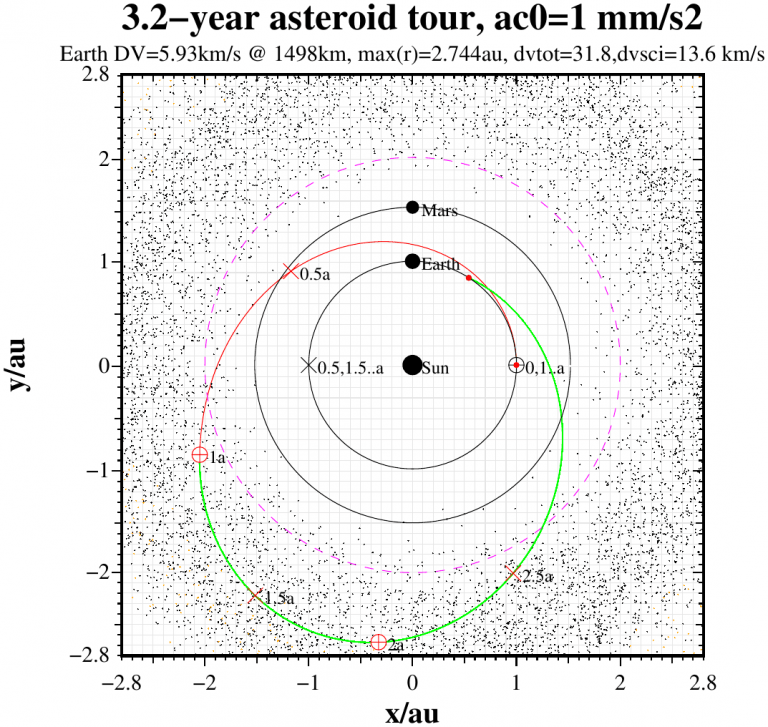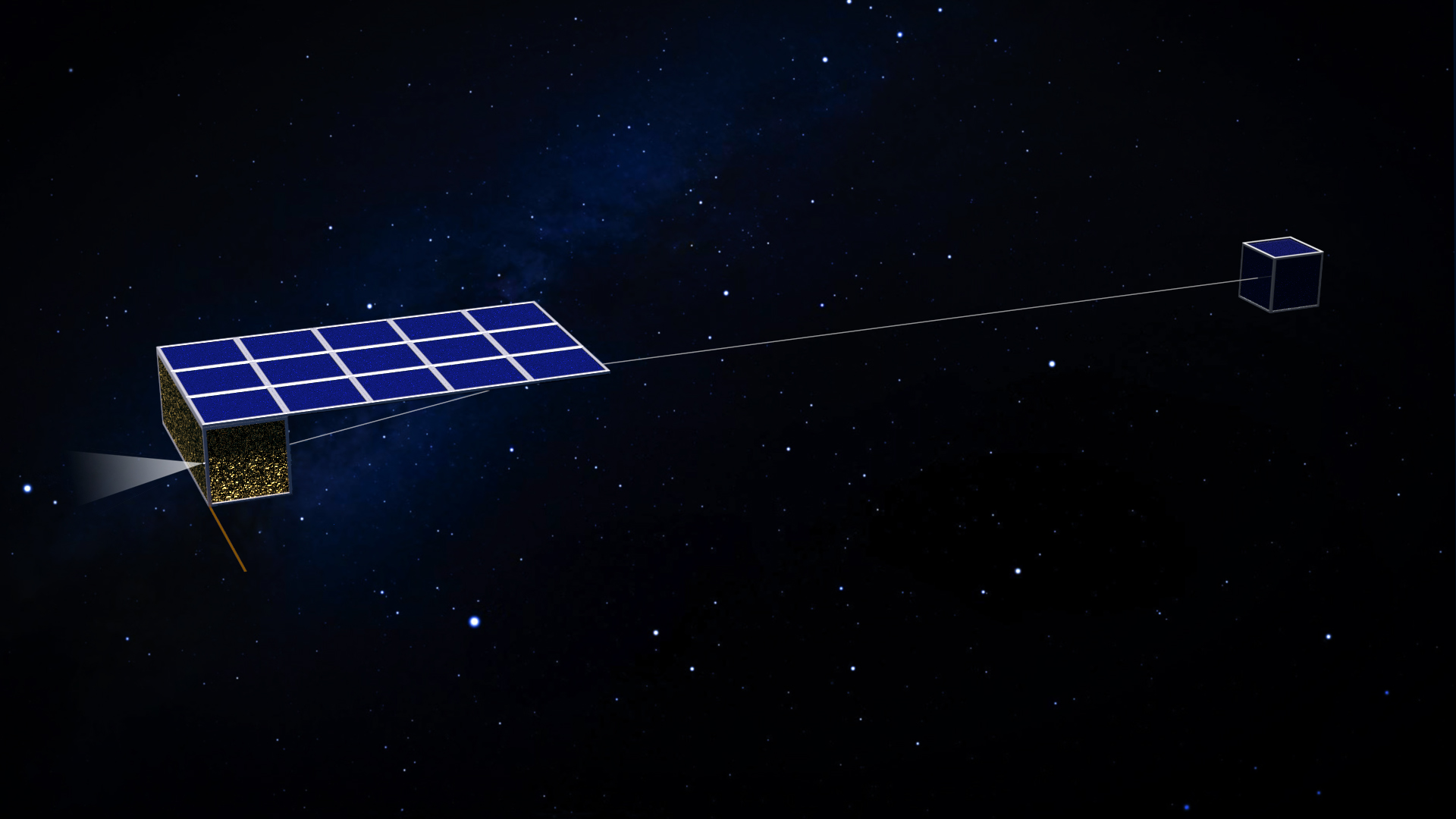The more that planetary astronomers study asteroids, they more they’re realizing just how varied and different they can be. Some, like 16 Psyche are made of solid nickel and iron, while others are made of rock. Some asteroids have been found with moons, rings, and some icy objects really blur the line between comet and asteroid. In order to truly understand their nature, it would take dozens or maybe hundreds of individual missions on the scale of Rosetta or New Horizons.
Or maybe not.

A team of researchers with the Finnish Meteorological Institute announced today that the best way to explore the varied objects in the asteroid belt would be with a fleet of tiny nanosatellites – 50 ought to do the trick to explore 300 separate asteroids, bringing the individual costs down to a few hundred thousand dollars per asteroid. During a presentation they made at the European Planetary Science Congress (EPSC) 2017 in Riga on Tuesday, the researchers showed how these tiny satellites could travel out to the asteroid belt, gather data on individual asteroids, and return to Earth to download their data.
The 50 satellites could be launched together in a single vehicle, and then separate once in space, or they could fill extra space in existing launches. The exact launch orbit doesn’t matter, as long as the spacecraft can get outside the Earth’s protective magnetosphere, where they can catch a ride on the solar wind.
Once in space, 5-kg spacecraft would deploy a 20 km-long wire tether that would catch the solar wind; the constantly flowing particles coming off the Sun, imparting a tiny thrust. This is known as an “E-sail” or electric sail. Unlike a solar sail, which depends on the momentum of photons coming from the Sun, electric sails harvest the momentum of charged protons.

Researchers are still figuring out if this is an effective propulsion system for spacecraft. An Estonian prototype satellite was launched back in 2015, but its onboard motor failed to reel out its tether. The Finnish Aalto-1 satellite launched in June, 2017, and will test out a prototype electric sail in addition to several other experiments over the course of the next year. Even more advanced versions have been proposed, such as Heliopause Electrostatic Rapid Transit System (or HERTS), a mission which could reach 100 astronomical units in 10-15 years by deploying a huge electrified net in space.
In the case of this asteroid mission, each satellite’s electric sail would only give it a change in velocity of only one millimeter per second, but over the course of a 3.2 year mission, it would allow the spacecraft to reach the asteroid belt and return to Earth.

Each satellite would be equipped with a telescope with only a 40 mm aperture. That’s the size of a small spotting scope or half a pair of binoculars, but it would be enough to resolve features on the surface of an asteroid as large as 100 meters across from 1,000 km away. In addition to taking visual images of the asteroid targets, the spacecraft would be equipped with an infrared spectrometer to determine its meteorology.
Because the spacecraft are so small, they won’t be capable of carrying a transmitter to send their data back to Earth. Instead, they’d store all their scientific findings on a memory card, and then dump their data when their orbit brings them back close to Earth.
The researchers estimate that development of the mission would probably cost about 60 million Euros, or $70 million dollars, bringing the cost per asteroid down to about 200,000 Euros or $240,000.
Further Reading: Europlanet, Science Daily


I was going to ask, 1 mm per second per what. But I see in the image it’s per second squared. This seems like a lot of acceleration from charged particles. How does it compare to acceleration from photons?
How will the data be dumped when back at Earth? Is there a transmitter in there that can send the data from closer to Earth? Or does the satellite have to be captured for it’s memory card to be recovered?
Will the satellite be able to avoid collisions in any way? It can’t be controller from Earth and the acceleration is too low for evasive maneuvers unless threats are spotted very early.
If we want to send interstellar probes, then this is the sort of thing we would do, only more so. It would be difficult to transmit information over the huge distances, so it may be easier to get the probe to come back with the information. We would want some sort of sail to accelerate away from the sun, brake as we approach the other star; and then do everything in reverse to come back again. Collisions are pretty unlikely, but the craft will need to steer itself towards anything it wants to look at.
What other kind of missions and tasks could be done by such small “swarms” of nanosatellites and probes? If sent to longdistance missions ultimately out of the solar system like the Voyagers and others decades ago, it is not hard to imagine they could be used both to find more objects, “near” (to solar system) as well as far away by simultaneously observing and comparind the same locations, while searching for eclipses not visible from earth, finding and making more precise measurements (parralax and other) of distances as well as size of nearby planetary systems and objects at the far side of solar system? All for a relatively affordable prize at least in this context.
“The Finnish Aalto-1 satellite launched in June, 2017, and will test out a prototype electric sail…”
I once owned a car that came equipped with a telescoping radio antenna. You might be able to use the same concept to create an electric sail. You have a spherical nanosatellite studded with telescoping elements of the electric sail, each of which could be deployed depending on which direction you wanted the satellite to go and all controlled by a simple computer. It could be like a celestial windjammer!